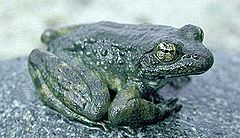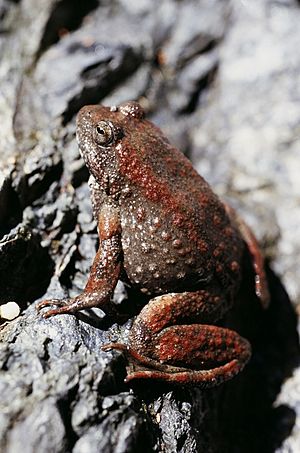Foothill yellow-legged frog facts for kids
Quick facts for kids Foothill yellow-legged frog |
|
|---|---|
 |
|
| Conservation status | |
| Scientific classification | |
| Kingdom: | |
| Phylum: | |
| Class: | |
| Order: | |
| Family: | |
| Genus: | |
| Species: |
R. boylii
|
| Binomial name | |
| Rana boylii Baird, 1854
|
|
The Foothill Yellow-legged Frog (Rana boylii) is a small-sized (3.72-8.2 cm) frog from the Rana genus in the Ranidae family. This species can be found from northern Oregon, down California’s west coast, and into Baja California, Mexico. Both the Columbia Spotted Frog and the Cascades Frog, also part of the Rana genus, live in the northern regions of this frog's territory. They prefer to live in streams and rivers, and lay their eggs in masses attached to rocks underwater. It takes anywhere from 5 to 30 days for the eggs to hatch, depending on the temperature of the water.
Contents
Appearance
The Foothill Yellow-legged Frog has a grey, brown, or reddish dorsum, or the back of the frog. It is commonly spotted or mottled but occasionally is plainly colored. Adults have yellow coloration under the legs, which may extend to their abdomen, but this characteristic is faint or absent in young frogs. There is a triangular, buff-colored patch on the snout, and, unlike other frogs in the Rana genus, there is no eye stripe. The throat and chest are often boldly mottled; moreover, the species has indistinct dorso-lateral skin folds and granular skin. Males of this species develop a nuptial pad on their thumb base during the breeding season.
These frogs can be identified by their rough skin, horizontal pupils, fully-webbed hind feet, and its habit to jump into moving water. However, tadpoles of this species resemble that of their rival, the Western Toad or Bufo boreas. The R. boylii as tadpoles have fairly flattened tails that lack color at the end and are the tallest in the mid section. The mouth of the tadpoles are made for suction to rocks with lip, known as labial, teeth rows used for scraping algae and diatoms, unicellular algae with cells walls that contain silica, off of the rocks they are clinging to. The mouth of the young R. boylii is also helpful in identifying it against the B. boreas because the young Foothill Yellow-Legged frogs develop more defined teeth rows after three weeks while their counterparts do not.
Food sources
Food supplies such as algae that the tadpoles eat also affects the fitness, or strength to reach sexual maturity, of the species. It has been reported that the “amount of protein in different algae, can affect size at and time to metamorphosis” and that “these food effects may be mediated through diet induced changes in thyroid function,” which means that the food that the tadpoles ingest dictates the changes in their thyroid gland production of certain proteins. This report, however, is one of the first to address this issue and so repeated results have yet to be done. Tadpoles most commonly dine on algae, diatoms, and detritus. As the species grows older, it changes its diet to animal tissue which must be swallowed whole because the frog's jaw is structured on a hinge joint that does not allow for sideways movement like in humans. Adult frogs eat a range of items such as moths, ants, grasshoppers, hornets, beetles, flies, water striders, and snails.
Mating habits
The mating “ceremonies” begin in spring where adult frogs congregate on sandy and/or rocky bars to mate. It was previously believed that they did so from March to May, but recent experiments have determined that time to be closer to April to late June. High stream velocities, however, may dislodge R. boylii egg masses from oviposition substrates. Thus, R. boylii avoids rapid waters to protect the egg masses from being swept away. This technique is why the species has a wide window for breeding season. If the conditions are not perfect to their standards, they will refuse to mate and will wait until the water velocities go back down to ideal.
The males perform mating calls mostly underwater, and those above the water are faint and hard to hear over fifty meters. After the frogs have successfully mated, the egg masses are positioned about half a meter down in the river and with flow velocities ranging from 0.1 to 0.6 m3/second. These egg masses can be anywhere from 100 to 1000 eggs in one batch. They are contained in a bluish gel that disappears once the eggs take on water, and the dark ovum, center of egg, is covered by three jelly envelopes that are about 5.4 mm in diameter. Eggs hatch in about five to over thirty days depending on the temperature that the mass is at and the surrounding water. The tadpoles continue to stay associated with the egg mass for several days, and continue to need higher temperatures to grow quickly. By the time the tadpoles reach about forty millimeters, roughly 1 and a half inches, they are adults and their reproductive organs are mostly functional. The frogs usually are fully developed by the first summer after their first metamorphosis, though some begin breeding after six months.
Habitat
The Foothill Yellow-Legged Frog has a territory that spans from northern Oregon, down California's coast where it is the most commonly found, and into Baja California, Mexico. They prefer to be in streams and rivers versus still ponds and pick flowing water that has either rocky substrate or sunny banks. They also pick rivers and streams that contain shallow areas that still have water flow.
Chemical defense
The frog uses the hydrophobic (water repellent) sections of the peptide to block access to fungi that want to attach to the amphibian. This ability can also be found in other Rana species including the Cascades Frog and the Moor Frog. The prior secretes a milky substance that fights against fungal infections and the latter uses its capability to have males turn blue during mating season. Still, the Foothill Yellow-Legged Frog's chemical defense has not been fully examined and is in the process of being understood. Although not much is known about it, this ability of the species has been of interest to many anti-fungal cream companies because of its overall effectiveness. However, current pesticide use has caused problems for the frog. So far, it has been concluded that though exposure to carbaryl, a substance found in common pesticides, does not kill the frogs, it does lower the peptides’ abilities to defend the species against invaders like the chytrid, B. dendrobatidis. More research is being done to see the full effects that pesticides may have on R. boylii.
Environmental issues
Along with the problems associated with pesticides being washed up in the Foothill Yellow-Legged Frog's habitat, in Trinity County, California there is a dam on the major river of the frog's home. By placing it there, they have altered about 94% of the possible procreation areas for the frogs, which has greatly affected the population.
Predators
The foothill yellow-legged frog is a natural prey of diving beetles, water bugs, garter snakes, rough-skinned newts, bullfrogs, and native toads such as Bufo boreas subspecies.
See also
 In Spanish: Rana boylii para niños
In Spanish: Rana boylii para niños





